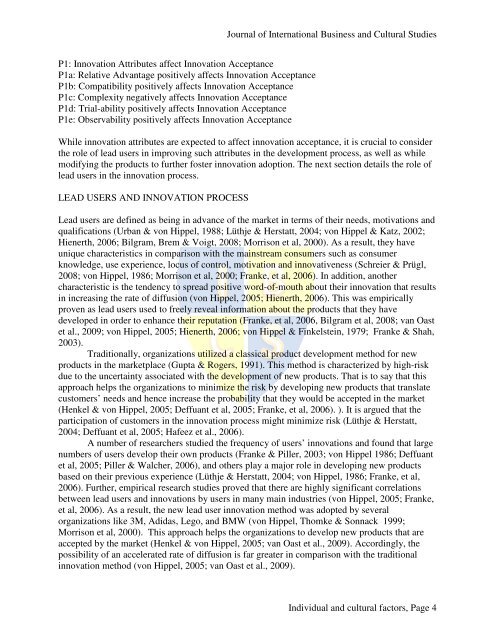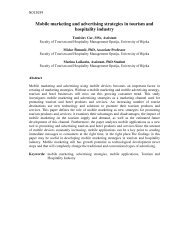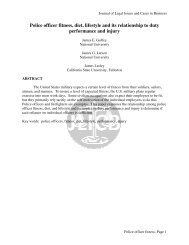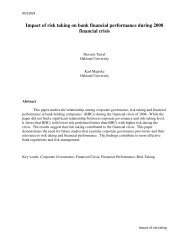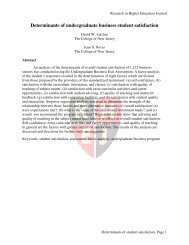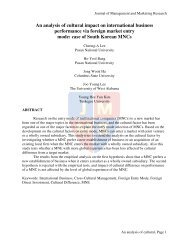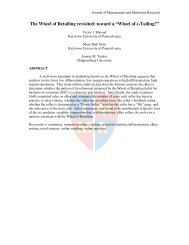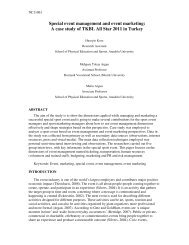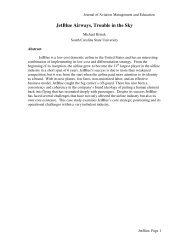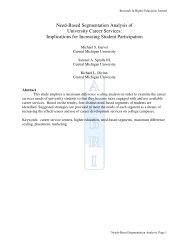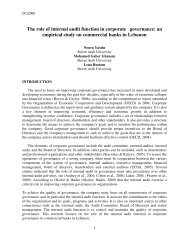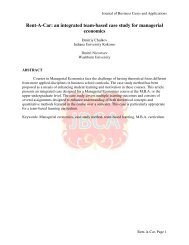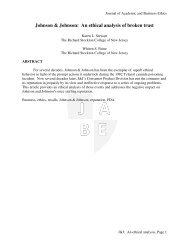Individual and cultural factors affecting diffusion of innovation
Individual and cultural factors affecting diffusion of innovation
Individual and cultural factors affecting diffusion of innovation
Create successful ePaper yourself
Turn your PDF publications into a flip-book with our unique Google optimized e-Paper software.
P1: Innovation Attributes affect Innovation Acceptance<br />
P1a: Relative Advantage positively affects Innovation Acceptance<br />
P1b: Compatibility positively affects Innovation Acceptance<br />
P1c: Complexity negatively affects Innovation Acceptance<br />
P1d: Trial-ability positively affects Innovation Acceptance<br />
P1e: Observability positively affects Innovation Acceptance<br />
Journal <strong>of</strong> International Business <strong>and</strong> Cultural Studies<br />
While <strong>innovation</strong> attributes are expected to affect <strong>innovation</strong> acceptance, it is crucial to consider<br />
the role <strong>of</strong> lead users in improving such attributes in the development process, as well as while<br />
modifying the products to further foster <strong>innovation</strong> adoption. The next section details the role <strong>of</strong><br />
lead users in the <strong>innovation</strong> process.<br />
LEAD USERS AND INNOVATION PROCESS<br />
Lead users are defined as being in advance <strong>of</strong> the market in terms <strong>of</strong> their needs, motivations <strong>and</strong><br />
qualifications (Urban & von Hippel, 1988; Lüthje & Herstatt, 2004; von Hippel & Katz, 2002;<br />
Hienerth, 2006; Bilgram, Brem & Voigt, 2008; Morrison et al, 2000). As a result, they have<br />
unique characteristics in comparison with the mainstream consumers such as consumer<br />
knowledge, use experience, locus <strong>of</strong> control, motivation <strong>and</strong> innovativeness (Schreier & Prügl,<br />
2008; von Hippel, 1986; Morrison et al, 2000; Franke, et al, 2006). In addition, another<br />
characteristic is the tendency to spread positive word-<strong>of</strong>-mouth about their <strong>innovation</strong> that results<br />
in increasing the rate <strong>of</strong> <strong>diffusion</strong> (von Hippel, 2005; Hienerth, 2006). This was empirically<br />
proven as lead users used to freely reveal information about the products that they have<br />
developed in order to enhance their reputation (Franke, et al, 2006, Bilgram et al, 2008; van Oast<br />
et al., 2009; von Hippel, 2005; Hienerth, 2006; von Hippel & Finkelstein, 1979; Franke & Shah,<br />
2003).<br />
Traditionally, organizations utilized a classical product development method for new<br />
products in the marketplace (Gupta & Rogers, 1991). This method is characterized by high-risk<br />
due to the uncertainty associated with the development <strong>of</strong> new products. That is to say that this<br />
approach helps the organizations to minimize the risk by developing new products that translate<br />
customers’ needs <strong>and</strong> hence increase the probability that they would be accepted in the market<br />
(Henkel & von Hippel, 2005; Deffuant et al, 2005; Franke, et al, 2006). ). It is argued that the<br />
participation <strong>of</strong> customers in the <strong>innovation</strong> process might minimize risk (Lüthje & Herstatt,<br />
2004; Deffuant et al, 2005; Hafeez et al., 2006).<br />
A number <strong>of</strong> researchers studied the frequency <strong>of</strong> users’ <strong>innovation</strong>s <strong>and</strong> found that large<br />
numbers <strong>of</strong> users develop their own products (Franke & Piller, 2003; von Hippel 1986; Deffuant<br />
et al, 2005; Piller & Walcher, 2006), <strong>and</strong> others play a major role in developing new products<br />
based on their previous experience (Lüthje & Herstatt, 2004; von Hippel, 1986; Franke, et al,<br />
2006). Further, empirical research studies proved that there are highly significant correlations<br />
between lead users <strong>and</strong> <strong>innovation</strong>s by users in many main industries (von Hippel, 2005; Franke,<br />
et al, 2006). As a result, the new lead user <strong>innovation</strong> method was adopted by several<br />
organizations like 3M, Adidas, Lego, <strong>and</strong> BMW (von Hippel, Thomke & Sonnack 1999;<br />
Morrison et al, 2000). This approach helps the organizations to develop new products that are<br />
accepted by the market (Henkel & von Hippel, 2005; van Oast et al., 2009). Accordingly, the<br />
possibility <strong>of</strong> an accelerated rate <strong>of</strong> <strong>diffusion</strong> is far greater in comparison with the traditional<br />
<strong>innovation</strong> method (von Hippel, 2005; van Oast et al., 2009).<br />
<strong>Individual</strong> <strong>and</strong> <strong>cultural</strong> <strong>factors</strong>, Page 4


